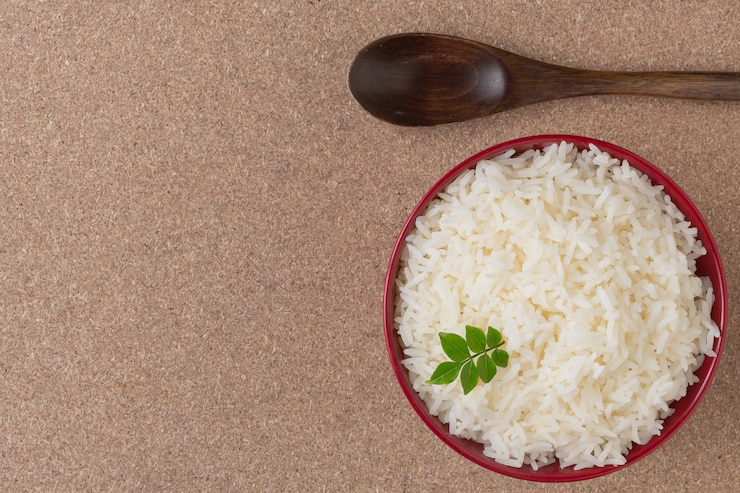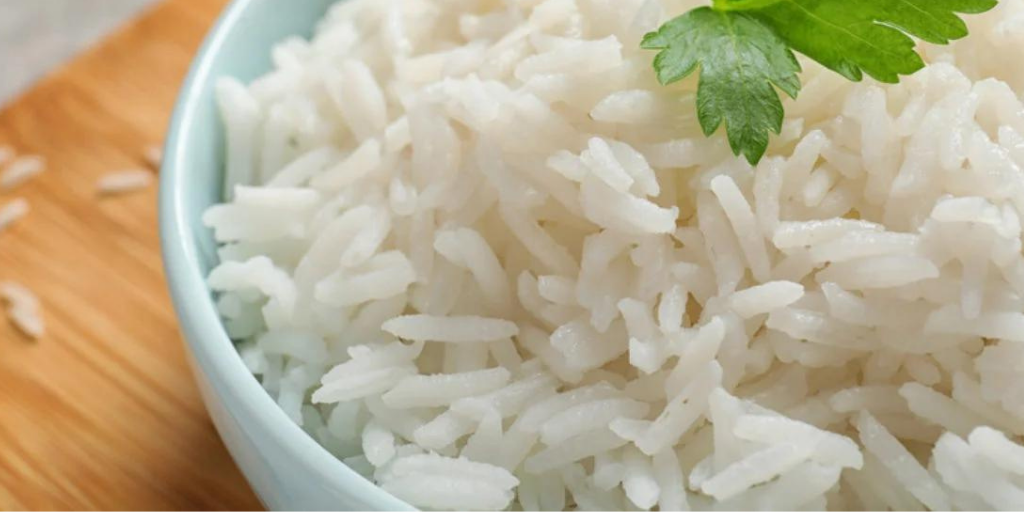Perfectly cooked rice is soft, chewy, and somewhat sticky, in my opinion. Once the rice is cooked, you should see the individual grains. Cooking rice with too much water causes the structure of the rice to break down, resulting in mushy rice.
You’ll notice that I don’t use as much water in the stovetop and slow cooker procedures as I do in other recipes, and I believe those recipes call for far too much water. As a result, the mushy rice at the bottom of the pot is ordinary. It’s an art to get the proper rice-to-water ratio! To get perfectly cooked jasmine rice every time.
Jasmine rice is buttery and fluffy and goes well with various Asian dishes. You may wind up with sticky, gummy rice that sticks to the bottom of the pan if you don’t use the proper water-to-rice ratio and cooking procedure. Learn how to cook jasmine rice on the stovetop, in a rice cooker, or in an Instant Pot step by step.
What Is Jasmine Rice?
Thailand gave birth to jasmine rice, a fragrant variety of rice. Since a local farmer found it in 1945, it has been referred to as Thai Hom Mali Rice, and improved cultivars have been created.
Jasmine rice has a particular flavor and scent thanks to an aromatic amino aldehyde gene, and it cooks a delicate, fluffy texture.
The most popular type of jasmine rice is white, but brown types are also available. The look of uncooked white grains is polished, transparent, and glossy. Thai stir-fries, congee, and rice puddings are good for jasmine rice.
How To Cook Jasmine Rice?
1. Cook Jasmine Rice On The Stove
The conventional stovetop approach may require more attention than fancy appliances like a rice cooker or an electric pressure cooker, but there’s no denying it’s still the most straightforward.
Simmer jasmine rice on the stove for 10 to 15 minutes or until all the water has been absorbed. After that, remove the rice from the fire and set it aside for about 10 minutes.
2. Cook Jasmine Rice In A Rice Cooker
First, remember that cooking times may vary depending on your device, so always follow the manufacturer’s directions. Many rice cookers come pre-programmed with jasmine rice. In general, jasmine rice takes about 25 minutes to cook in a rice cooker.
3. Cook Jasmine Rice In An Instant Pot
When it comes to essentials like rice, the Instant Pot shines. According to the Instant Pot, Jasmine rice should be cooked under high pressure for 3 to 5 minutes.
But don’t forget to account for the time it takes the Instant Pot to create pressure and then naturally release it after the timer goes off. If you’re using a different brand of electric pressure cooker, make sure you follow the directions provided by the manufacturer.
How To Store Jasmine Rice?
Dry jasmine rice should be kept cool and dry in an airtight container. Jasmine rice can be stored in the fridge for three to five days or frozen for up to six months once cooked. For more information, see our rice storage and reheating guide.
Uncooked jasmine rice will last virtually indefinitely if stored in a cool, dry pantry. Cooked jasmine rice will last 3 to 5 days in an airtight container in the refrigerator. Alternatively, split it out and freeze it in a freezer bag or freezer-safe container for six months.
What Makes Jasmine Rice So Special?
Brown jasmine rice is lower in calories and carbohydrates than white rice due to its fiber content. Calcium, iron, and potassium are also present. Furthermore, different quantities of beneficial phytonutrients can be found in red, purple, and black kinds of whole-grain jasmine rice.
Jasmine rice is grown mainly in Southeast Asia, particularly Thailand, and has a long grain. It’s good cooking quality due to its fluffiness and slightly sticky texture.
On the other hand, white rice has a wide range of consistency. Jasmine rice is rice with a long gray, and it is longer and thinner than most other rice varieties. It also has a fluffy texture rather than soft and clumpy when cooked. White rice isn’t a rice variety.
What Are The Benefits Of Jasmine Rice?
1. Jasmine Rice Has A Beautiful Aroma
The scented kind of rice with long grains is known as jasmine rice. The aroma of these grains comes from natural aromatic and fragrant substances produced by the rice plant, and 2-acetyl-1-pyrrolidine is the most significant scent component present. Thailand, Cambodia, and Vietnam are the primary producers of jasmine rice.
Jasmine rice is one of Thailand’s most popular and widely consumed rice varieties. The rice has a sticky texture and a slightly sweet flavor when cooked. Because it is not appropriate for frying and can become damp and soggy, jasmine rice is usually served steamed or boiled. Steamed jasmine rice complements curries and meats well. Jasmine rice, like other rice, is somewhat heavy in calories while providing numerous health advantages.
2. Can Help You Gain Energy And Weight
Jasmine rice can assist you in getting through diets where you need to acquire weight or bulk up. One serving of jasmine rice can help around 180 calories in a cup of cooked jasmine rice. f you want to carb-load or get some quick energy.
The starch in the rice will be converted into fuel, which will offer your body energy and power. People who want to gain weight should eat jasmine rice because the high-calorie content may help them achieve a healthy weight increase.
3. Have a Happy Pregnancy
Jasmine rice contains the synthetic folate folic acid (vitamin B9). Consuming folic acid is essential during pregnancy since it can help the fetus develop. Consuming folic acid prior to conception can aid in preventing birth issues like neural tube defects, which can result in brain or spine defects.
Folic acid in the mother’s body can aid in the healthy development of the heart and blood vessels of the developing baby. Given the preceding considerations, jasmine rice may be suitable for folic acid intake during pregnancy.
4. High Iron Levels
Iron is necessary for developing our immunity and producing energy by cells and oxygen delivery to our tissues. Iron-rich jasmine rice can aid in synthesizing red blood cells in our bodies.
Anemia, a disorder characterized by fatigue, headaches, a rapid heart rate, and shortness of breath, is caused by a lack of iron. Iron can also aid in maintaining healthy hair, skin, and nails. Because women lose iron during menstruation, jasmine rice can assist them in obtaining enough iron levels.
5. High In Fiber Content
Brown jasmine rice is abundant in insoluble fiber, which helps to keep our digestive tracts in good shape. Brown jasmine rice is less processed than other rice species; thus, it retains many nutrients.
This jasmine rice can help us stay fuller for longer and avoid overeating. It can also assist us in overcoming the problem of constipation. The fiber in jasmine rice softens our stools and aids in absorbing nutrients from the food by slowing the flow of food through our bodies.
6. Other Health Benefits
Phytonutrients in jasmine rice protect our cells and boost our immunity. Jasmine rice is high in manganese, a mineral essential for our bodies’ proper functioning.
This type of rice can also be an excellent item to add to athletes’ diets or people participating in endurance-building activities. Both white and brown jasmine rice can help our muscles store glycogen, which is necessary for smooth, high-intensity workouts.
What Is The Taste Of Jasmine Rice?
Jasmine rice is a long-grain rice variety mostly farmed in Thailand, Cambodia, and Vietnam. It’s incredibly similar to basmati rice, except it’s a touch stickier and has a shorter grain. Thai fragrant rice is another name for it. Jasmine rice has a nutty flavor; some people compare it to popcorn.
Jasmine rice has a distinct aroma of buttered popcorn, fragrant flowers, and a sweet and nutty flavor. It has a light, fluffy, delicate texture and does not stay together like many glutinous “sticky” kinds.
The type of white rice determines the flavor difference between jasmine rice and other white kinds of rice. White rice is generally bland and somewhat sweet, and the flavor of jasmine rice is likewise rather dull. On the other hand, some people claim that jasmine rice has a nutty flavor or tastes like plants.
Conclusion
Jasmine rice has a unique perfume and flavor that complements Thai and other Asian cuisines. The most common jasmine rice type is white, a refined carbohydrate with a high glycemic index.
However, consuming too many refined carbs has been linked to obesity, diabetes, and cardiovascular disease, whereas whole grains in one’s diet provide health benefits. To lower the chance of developing adverse health concerns, it is better to use whole-grain rice varieties.
Rice also contains arsenic, which is hazardous to the human body. Rice eating and rice products should be limited to newborns and children under six, and these harmful substances can also be passed on to a fetus. Therefore, pregnant women should limit their rice consumption.

